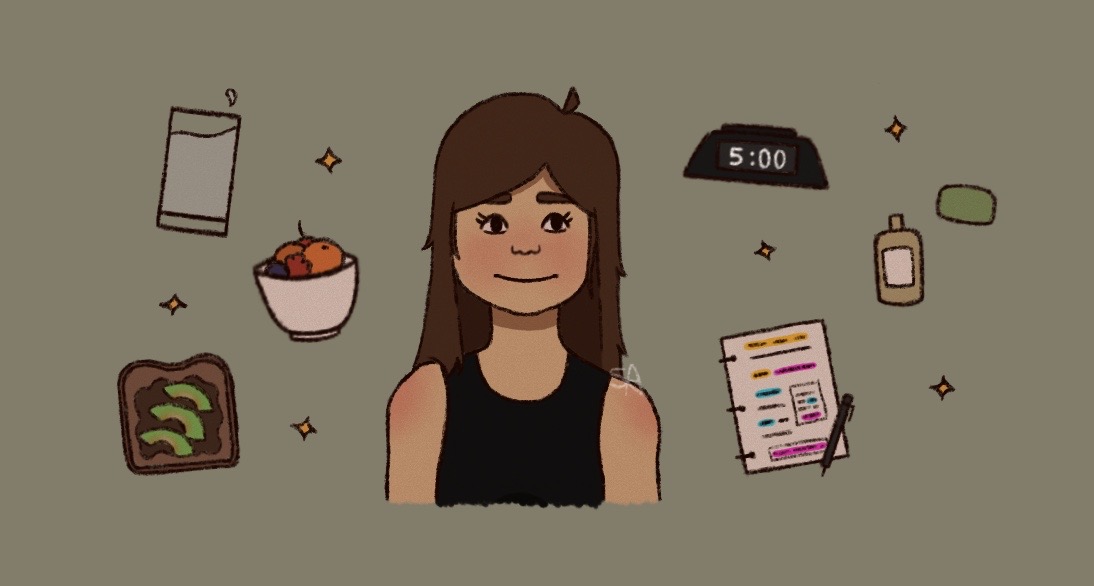An illustration of Editor-in-Chief Molly Harwell, a junior, depicts her as “that girl”, surrounded by various elements that make up the trend. The “that girl” trend, which was once used as an inspirational tool, has since become a promoter of disordered eating and hustle culture, causing unrealistic expectations in the lives of young people. “There is nothing wrong with re-inventing one’s lifestyle or making healthier choices in order to live and function better, but that crosses a line when those ideals cause harm to others, even by accident,” Harwell wrote. Illustration by Eleanor Robinson
Once used as a motivational tool, the “that girl” trend on TikTok has become a toxic fad that is causing discontent and hyperproductivity in young adults.
She wakes up at 4:30 a.m. every morning and heads to the gym in her matching outfit. She pampers herself, then drinks an iced coffee and sits down to read a book with the natural sunlight streaming through the windows in her New York City apartment.
Her life is a Pinterest board.
This idealized way of living is known to many as the “that girl” trend. Though it has always been around, the idea of being “that girl” rose in early April 2021, according to an article published by Bustle, an online women’s magazine, in August 2021. The hashtag “#that-girl” had nearly 800 million views on Instagram and TikTok by August of the same year.
The trend began as a way to motivate young women to eat healthy, work out and live life to their full potential. While this may not seem inherently harmful, it can cause young adults to develop unhealthy relationships with food.
It has also become a harmful instigator of toxic productivity and hustle culture.
An article by Global Health and Pharma stated that hustle culture is “the collective urge to work excessively; to be better than everyone else and work longer and harder to be at the top of our game.”
When caught in a cycle of hyperproductivity, it can be hard to rest under the pressure to keep working hard. The “that girl” trend can cause young adults to feel as if they are not living up to expectations if they take time to rest.
Because this trend only shows the high points of “that girl’s” life, it can be easy to fall for the lies.
“The (trend) is harmful. Honestly, I’ve cut way back on Facebook because you just get bombarded with this (content) and you actually start to believe that everyone’s life is perfect and yours isn’t,” Clarke County School District school psychologist Dr. Marcia Page said.
Along with this, the “that girl” trend has also encouraged disordered eating and orthorexia, a term for the unhealthy obsession with eating healthy food, according to WebMD.
The “that girl” trend can cause young adults to feel as if they are not living up to expectations if they take time to rest.
“The ‘that girl’ aesthetic is comparable to the clean-eating, wellness gurus of the 2010s — presenting extremely low-calorie, carb-lacking meals as aesthetically beautiful, all the while masking and spreading a fear of ‘unhealthy’ aka enjoyable, joyous food,” according to a July 2021 article by Refinery 29.
While the “that girl” trend has its faults, it isn’t entirely negative. Learning to look at this content in a different light can help change teenagers’ perspectives.
“I think that if you yourself post things, you can kind of count your blessings,” Page said. “But it all has to be taken in with this lens. This isn’t everything about this person’s life, only what they want (viewers) to see.”
To combat the effects of the trend, consumers of social media can unfollow content creators who create “that girl” videos on TikTok or press the “Not Interested” button on Instagram.
There is nothing wrong with re-inventing one’s lifestyle or making healthier choices in order to live and function better, but that crosses a line when those ideals cause harm to others, even by accident.
While the “that girl” trend doesn’t need to completely die off, it does need to be re-invented to be more inclusive and create a safe, healthy environment for all.
